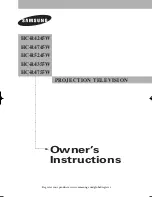
CHAPTER 3: ETHERNET INTERFACE
350 REDUNDANCY OPTIONS
SR3 SERIES PROTECTIVE RELAY PLATFORM – COMMUNICATIONS GUIDE
3-3
functions are grouped into logical layers. A layer serves the layer above it and is
served by the layer below it. There are 7 layers: physical, data link, network, transport,
session, presentation, application.
•
DANP – Doubly Attached Node running PRP – a node that has two ports which operate
in parallel and are attached to the upper layers of the OSI communications stack
through a Link Redundancy Entity module.
•
DANH – Doubly Attached Node with HSR protocol.
•
LRE - Link Redundancy Entity – module operating at the link layer of the OSI stack and
responsible for handling duplicates and managing redundancy.
•
SAN – Singly Attached Node – regular nodes with non-redundant network adapters
•
RedBox – device attaching singly attached nodes (SANs) to a redundant network.
•
RCT – Redundancy Check Trailer – PRP trailer added to frames and consisting of the
following fields:
–
16-bit sequence number (SeqNr);
–
4-bit LAN identifier (LanId);
–
12 bit frame size (LSDUsize);
–
16-bit suffix (PRPsuffix).
350 Parallel Redundancy Protocol (PRP)
PRP defines a redundancy protocol for high availability in substation automation
networks. It is applicable to networks based on Ethernet technology (ISO/IEC 8802-3).
PRP is designed to provide seamless recovery in case of a single failure in the network, by
using a combination of LAN duplication and frame duplication technique. Identical frames
are sent on two completely independent networks that connect source and destination,
see next figure.
Figure 3-3: Example of PRP Redundant Network
Under normal circumstances both frames will reach their destination and one of them will
be sent up the OSI stack to the destination application, while the second one will be
discarded. If an error occurs in one of the networks and traffic is prevented from flowing on
that path, connectivity will still be provided through the other network to ensure
continuous communication. However, care must be taken when designing the two LANs,
so that no single point of failure (such as a common power supply) is encountered, as such
scenarios can bring down both LANs simultaneously.
PRP uses specialized nodes called doubly attached nodes (DANPs) for handling the
duplicated frames. DANPs devices have an additional module at the link layer level, called
the Link Redundancy Entity (LRE). LRE is responsible for duplicating frames and adding the
specific PRP trailer when sending the frames out on the LAN, as well as making decisions
on received frames as to which one is sent up the OSI stack to the application layer and
which one is discarded. In essence LRE is responsible for making PRP transparent to the
higher layers of the stack. There is a second type of specialized device used in PRP
networks, called RedBox, with the role of connecting Single Attached Nodes (SANs) to a
redundant network.
















































